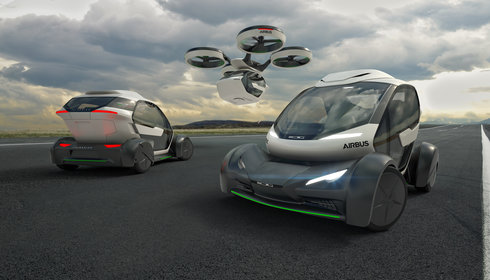
27/07/2017
Flying cars, four wheels ready to take-off
Dino Collazzo
The first few models could be unveiled already as early as the end of this year thanks to projects financed by innovative companies. The automotive sector though, has no intention of taking a back seat and is trying to get into this business. But for now unsuitable infrastructures, safety risks and the absence of dedicated regulations are clipping the wings of these “flying machines”.
Automobiles are ready to take-off. The idea of seeing cars flying around over our cities is not so far-fetched as one might think. Or at least this is what some of the largest manufacturers think and have decided to invest on "flying cars", announcing the first prototypes by the end of the year. These are vehicles, equipped with rotors or propellers able to take the air when needed. But these futuristic four wheelers have to contend with a number of yet unresolved issues linked to infrastructure and mobility.
Sure, the sector is still in an embryonic phase and before being able to really take-off, a series of dedicated government norms and regulations will have to be approved. Nevertheless, a number of companies strongly believe in the feasibility of the project, so much so that large capitals have been invested in designing flying cars. Some have already been testing, with some success, the first prototypes, and the intention is to launch on the market the first flying cars starting from 2025. These cars are obviously not accessible to all pockets but are destined in the long run to revolutionize mobility, as several analysts imagine autonomously driven taxis flying over our cities, public passenger transport services (pay-per-ride), corporate leasing, vehicles able to reach critical areas by air to deliver health and food aid, all the way to mass production and marketing of private vehicles. The busiest companies on these projects are: Ehang who is developing a vertical take-off and landing drone with autonomous driving capability; Toyota who has just filed a patent for Aerocar, a flying car able to change shape; Airbus that additionally to the Vahana project – a self-driving taxi that will enter production by 2021 – is developing together with Italdesign the model Pop.Up (half car half drone, able to adapt to traffic conditions and choose via an application whether to take-off or move on the roads); Uber too is planning to launch a flying taxi service in Dallas and Dubai by 2020; Kitty Hawk, backed by hefty investments from the likes of Google and AeroMobil, is also developing a flying car whose prototype is equipped with wings that fold once on the ground.
However, before witnessing the birth and development of this “Back to the Future” scenario, a series of issues related to difficult mass marketing, take-off and landing in urban areas, noise, human error, fuel efficiency, safety and air traffic control will need to be resolved. According to a study by Frost & Sullivan (Future of Flying cars, 2017-2035) in order to overcome these obstacles, “flying car” manufacturers should forge partnerships with specialists in the various sectors involved, whether technological, automotive and aerospace, in order to improve vertical take-off and landing capabilities, autonomous in-flight technologies and the development of fail-safe functions. For the automotive industry and its supply chain the opportunities to expand their business, thanks to the development of the flying car, could be remarkable. But these must be seized now, through investment in research and development in the field of artificial intelligence, ultra light materials, connectivity, or by financing innovative hi-tech start-ups. The challenges now facing manufacturers and their OEMs as well as the IAM supply chain – especially the component sector – is having to cope with an increasingly competitive market where new players have made their entrance. The risk, in underestimating this new ecosystem, is to go, within a few years, from leaders of the pack to pursuers.
Sure, the sector is still in an embryonic phase and before being able to really take-off, a series of dedicated government norms and regulations will have to be approved. Nevertheless, a number of companies strongly believe in the feasibility of the project, so much so that large capitals have been invested in designing flying cars. Some have already been testing, with some success, the first prototypes, and the intention is to launch on the market the first flying cars starting from 2025. These cars are obviously not accessible to all pockets but are destined in the long run to revolutionize mobility, as several analysts imagine autonomously driven taxis flying over our cities, public passenger transport services (pay-per-ride), corporate leasing, vehicles able to reach critical areas by air to deliver health and food aid, all the way to mass production and marketing of private vehicles. The busiest companies on these projects are: Ehang who is developing a vertical take-off and landing drone with autonomous driving capability; Toyota who has just filed a patent for Aerocar, a flying car able to change shape; Airbus that additionally to the Vahana project – a self-driving taxi that will enter production by 2021 – is developing together with Italdesign the model Pop.Up (half car half drone, able to adapt to traffic conditions and choose via an application whether to take-off or move on the roads); Uber too is planning to launch a flying taxi service in Dallas and Dubai by 2020; Kitty Hawk, backed by hefty investments from the likes of Google and AeroMobil, is also developing a flying car whose prototype is equipped with wings that fold once on the ground.
However, before witnessing the birth and development of this “Back to the Future” scenario, a series of issues related to difficult mass marketing, take-off and landing in urban areas, noise, human error, fuel efficiency, safety and air traffic control will need to be resolved. According to a study by Frost & Sullivan (Future of Flying cars, 2017-2035) in order to overcome these obstacles, “flying car” manufacturers should forge partnerships with specialists in the various sectors involved, whether technological, automotive and aerospace, in order to improve vertical take-off and landing capabilities, autonomous in-flight technologies and the development of fail-safe functions. For the automotive industry and its supply chain the opportunities to expand their business, thanks to the development of the flying car, could be remarkable. But these must be seized now, through investment in research and development in the field of artificial intelligence, ultra light materials, connectivity, or by financing innovative hi-tech start-ups. The challenges now facing manufacturers and their OEMs as well as the IAM supply chain – especially the component sector – is having to cope with an increasingly competitive market where new players have made their entrance. The risk, in underestimating this new ecosystem, is to go, within a few years, from leaders of the pack to pursuers.






